#zero escape reference caption so true <3< /div>
Explore tagged Tumblr posts
Text
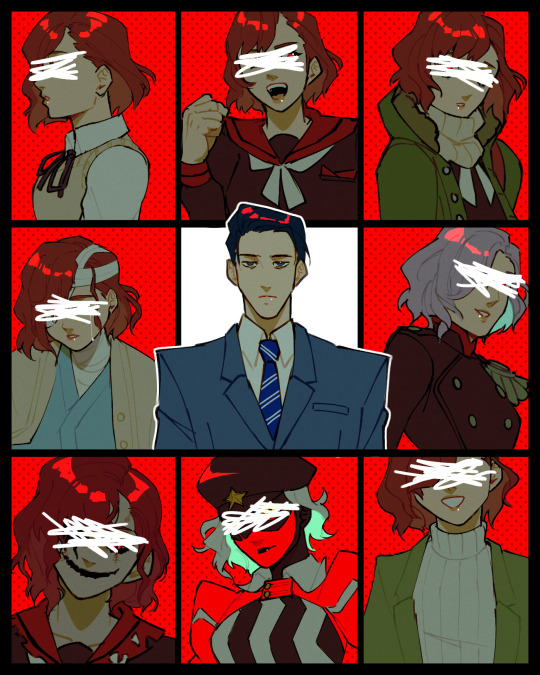
The Eri Natsuhara I know isn't here. She's not anywhere.

Version without the eyes scribbled out lol
#persona 5#p5#persona 5 tactica#p5t#persona 5 tactica spoilers#p5t spoilers#persona#toshiro kasukabe#eri natsuhara#erina#erina p5t#ernesto p5t#eritoshi#j's art#these 2 are fucking me up so bad 💔💔#zero escape reference caption so true <3
825 notes
·
View notes
Text
Unus Annus Secrets
Here I’m going to try and explain all of the Unus Annus codes + possible lore. If I have forgotten some information or if one of these links doesnt work/is incorrect please let me know. This post will be updated when needed.
This is LONG, so be prepared.
At first, these codes were only in videos edited by NerdFiction, but as of October 26th this is no longer true. (The possible exception to this would be the first video I’ve listed, as the editor is not in the description).
1) 5 Weird Apps That Predicted Our Death
“Here at Unus Annus the end is nigh... when the timer hits zero we will cease to exist. is it fate? is this a simulation? Can anybody hear me? My name is.... [FILE REDACTED]”. Timestamp - 0:14
2) Ethan Roasts Mark for 15 Minutes Straight
“and in the comments, you will read the words you soon will see are wise controlling pawns who type our deed ‘That is Discord, not FaceTime’” Timestamp - 0:40
“within this truth a question stands, is the pee sauna ever close?”. [“Pee Sauna”was uploaded about a week afterwards] Timestamp - 0:40
3) Our Fans Try to Scare Us with Their Homemade Creepypasta
“What will happen if the clock stops”
“Could I find a way to keep it going?”
“If neither hand is right, what deals are left?”
“Who is the master of the clock?” (all around 8:44)
4) Learning to Cry on Command to Increase Our Youtube Views
“remember the key, the incompletion of a logolept’s corrective action” [a logolept is “a person who takes a keen interest in words”. Marcus is likely referring to himself.] Timestamp - 1:49
“the long wait ends with twenty four more for a path of destiny chosen before”[“Pee Sauna” was uploaded the day after] (closely after the last code)
5) Becoming One With the Horse
“They heard me, I knew it could work!” (timestamp currently unknown; to be updated)
Around this time, NerdFiction’s Twitter bio said, among his normal information, that he was “trying to stop the Unus Annus clock from within.”
6) Preparing a 5-Star Meal for Our Youtube Famous Dogs
“I couldn’t stop it. Will I die with the machine?” (Timestamp - 21:33)
7) Does This Magnetic Skincare Routine Really Work?
“freed or so I thought. Another layer, but still the clock.” (Timestamp - 9:45)
“The Beginning of The End”.
On July 26th, at 12pm PST, a video was uploaded to Unus Annus titled “Traversing the Desert to Find Our Inner Truth”. This video was only up for a few minutes before it mysteriously disappeared, only to be replaced by another video, titled “The Beginning of The End”. At first glance, the videos were identical, save for different titles and slightly different descriptions. However, the second video was slightly longer than the first, and upon further inspection, many came to realize that the audio was slightly different as well. You can listen to both audios here. There was a rumor going around that the captions of “Traversing the Desert to Find Our Inner Truth” said something about looking out for Norbert Moses, but no one has been able to confirm this to my knowledge.
8) Puberty Simulator
“Happy birthday to the beast or to the body that once housed me. A transfer made for pity’s sake. Tricked into the machine as he had my cake.” (Timestamp - 14:36) [The same code was found a week earlier in “Mark and Ethan Shave Chica”, uploaded on NerdFiction’s birthday. The original code was very difficult to make out, so it is likely he inserted it into a different video to make it easier for us.]
On the same day, NerdFiction’s Twitter bio read “Everyone must leave something behind when he dies. Memento Memoriae” (remember memory)
In “The Koala Challenge: TikTok’s Intimate Couple’s Trend” one of the clips is edited to look like a TikTok video, with the user ron_somberest being used. Ron_Somberest is an anagram for Norbert Moses. This TikTok account does actually exist, and the icon is a zoomed in and brightened photo of Norbert Moses’s face with the eyes scribbled out.
Around this time NerdFiction’s Twitter bio read “’It’s not dark, never was’ - Ron Bestsmore”. Ron Bestsmore is also an anagram for Norbert Moses. It is possible that the “dark” being referred to here is Darkiplier, and NerdFiction is trying to imply that Dark is not involved in this.
About a week after the koala challenge video was “How to Start a Fire (except don’t)”, which featured an appearance from Unus. NerdFiction’s Twitter bio read “In the end, who is your savior and what are they saving you from?”
Things were quiet for about a month. NerdFiction eventually erased the cryptic message from his Twitter bio.
9) Learning To Use The Force
“wait no something is wrong. he knows!” (Timestamp - 10:45) [translated from small coded words hidden in the montage]
“STOPTHISWHATAREYOUDOINGO3″ (Timestamp - 11:40)
“it worked” (a spectrogram, derived from a sound played at the end of the video)
10) Momiplier Tells Us True Scary Stories from Korea
“As I was, as I’ve done to him now. Am I right to decide his fate?” (Timestamp - 5:44) [Right before this, Mark’s mom is talking about a nightmare she had where she was paralyzed, possibly implying that nerdfiction was once paralyzed and has now paralyzed someone else (pointed out by @/minervas-sandwich)]
11) Cryptid Olympics
“I thought you’d join us but, hey, that was just a theory, Memento Doctrina” (remember learning). (Timestamp - 5:49) [The code references the Game Theorists channel, which had uploaded a video about Unus Annus earlier that same day.]
- From here on, every video has had some sort of code -
12) Edward Pumpkin Hands - This was the first coded video not edited by NerdFiction, instead being edited by Diceroll.
At various points throughout the video small parts of a url are seen. When pieced together, this link is made: https://imgur.com/a/tyDewJ7. It leads to a photo of the Unus Annus hourglass. When edited, a series of binary text is shown, which translates to “zhIaNL2“. Inputting this into another imgur link gets you to https://imgur.com/a/zhIaNL2. After editing the photo (although you can still sorta see it without doing so), a cipher of a custom alphabet is shown (I posted an edited photo here).
At 5:01 in the video a weird image is shown for only a moment (a slightly brightened version of it here). Nobody knows what the hell it means.
At the same time, there is a reversed audio of someone (presumably Ethan; it sounds like him) saying “we did that”. For context, the sentence said right before that line was “if one of us dies, the other has to take over for the remainder of time”. This is possibly implying that someone, or multiple someones, has/have died and been replaced.
13) Blood Bath - edited by rad_r
“Everything’s fine”
The Unus Annus timer is shown. It counts down for three seconds before counting up for one second. Heavy breathing can be heard over it. It is then cancelled by an error message
“ITS NOT FINE HELP” (this and the previous two messages are hidden at 5:57)
“you’ve done it now.. a machine observed. there is no returning.. a machine unnerved. there is only.. a machine unconqured.” (right at the end of the video, before the timer)
14) The Unus Annus Annual Costume Contest - edited by nerdfiction
“I saw just one door in a hall filled with many, I locked your gate but they were too late to join me. He was re-placed, she was undone, I had escaped yet he had still won”. (Timestamp - 2:05) [possibly talking about diceroll and rad_r. The pronouns would line up, and it would make sense with those two now having edited coded videos.]
15) Ethan Turns Mark Into a Werewolf - edited by rad_r
“futility or farewell? only time time time.” (timestamp - 7:17)
16) Ethan Kidnapped Mark - edited by Diceroll
Two spectrograms are shown in this video; one at 14:08 and one at 17:38. Combined, they create an imgur link: https://imgur.com/a/gKB62sv
The imgur link shows a photo of a key. On the key is a code translating to “stop the clock”
At the end of the video before the timer is a set of text in the custom alphabet previously mentioned. Translated and decoded it translates to “I can hear it coming theres not much time left the ones that tried to stop it have had their hearts cleft it is now your turn to put this loop to rest take us out of here and show us a new nest”
17) Being Brutally Honest with Each Other
“It is alive, no longer living / misunderstood beats unforgiving / escaped that fate but lost the tale / does a hope yet remain or just one final nail?” (Timestamp - 26:03)
18) Recreating Every Single Unus Annus Video
“The bottom of the spiral” (timestamp - 10:55)
19) “All Our Video Ideas That Never Happened”
“Be careful for what you wish for” (taken from two different codes)
*20) The Unus Annus Last Supper + Who’s Cutting Onions In Here??? - both edited by rad_r
“We’ve asked... we’ve tried... is there no way to stop the end? To those who aren’t deterred: how much will you sacrifice to ascend?” (A quotefall puzzle, split into 2 parts)
21) Everything’s Legal If You’re Dead
Norbert Moses is mentioned at 10:50. Look closely, his name is only there for a couple frames.
These have been the only codes I’m aware of as of 11/11/20.
(be sure to check out @gemstone6’s list as well!!)
Link to my Unus Annus theory
989 notes
·
View notes
Text
TWB 1x04: The Wrong End of a Telescope - Analysis
So, I really loved this episode of TWB as well. Lots of good stuff in it.
Early on, the call the CRM the “hidden city.” I was really glad they said that because it further proves our Avalon theory. (Read HERE.)
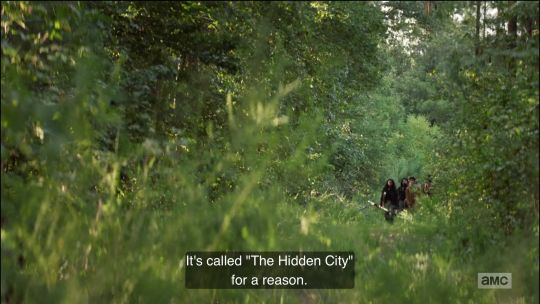
There was more talk of luck and being lucky in this episode as well. The group gets to a high school and decides to go in, both to get out of the rain and to scavenge for supplies.
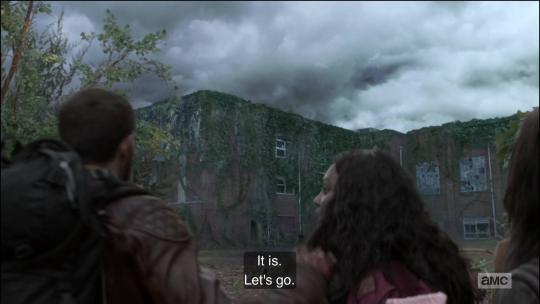
They end up dividing into three groups: Huck and Hope, Felix and Elton, Iris and Silas.
With Felix and Elton, they happen upon some iodine, and Elton calls it the “Holy Grail of water purification.” So, water theme. They also come upon a walker who’s stuck in a locker. (That rhymes, hehe.) But it’s actually locked into the locker with a padlock. It makes Elton claustrophobic and we some flashes of his past, though they’re not entirely clear yet.
I think this is an important theme, though. The walker is imprisoned and can’t get out. Felix couldn’t get it out if he’d wanted to because it was locked in, and he didn’t have a key. So key and lock theories, imprisonment, etc. At one point, we even saw Felix picking a lock, so it was there a lot.
It also becomes clear that there’s an animal, a predator, in the high school. We see it drag a walker away and hear it growling. As it turns out, it’s a wolf, living in the vacant school. Sirius Still feels, no? The first thing I thought of was the Up the Wolves song from Still and the idea of Beth being the mother wolf.
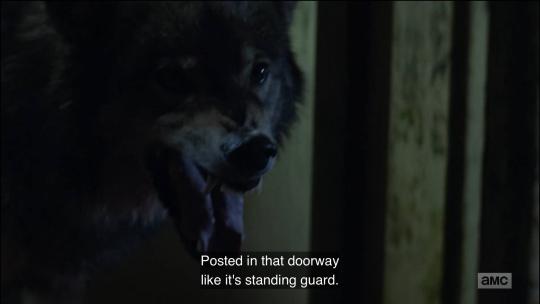
And get this: Huck and Hope are the ones who see it. They are looking at it (from behind a door) and decide it’s acting weird. It’s not pacing around or really trying to attack them or running away. It’s standing in the doorway like a sentinel. Huck apparently knows a thing or two about wolves and says it’s probably protecting it’s young.
So, we have a mother wolf protecting its children in a school with yellow walls and lots of water jugs. Hmmm.

The other thing is that Hope took a lesson from Huck and the wolf and applied it to her father. (We also get flashbacks of Hope arguing with her father in this episode, before he left with the CRM. He tells her some things that at first seem pretty innocuous, but also make me think she might be special in some way. We’ll have to wait to find out how/why.)
Anyway, Huck says sometimes you think you’re reading a situation right, but really there’s a lot going on you don’t know about. She said this in reference to the wolf. It wasn’t really out to get them; just protecting it’s young. And Hope took that and applied it to herself saying perhaps she’d totally misunderstood her dad all those years and there was a lot more going on than she knew.
So, for me, the line about being a lot more going on that you’re not seeing could apply to Beth and TD, no? But also, the fact that Hope applied it to her dad gives me hope that maybe Beth’s story will, as we’ve theorized, be tangled up with the father and his research in some way. I can’t help but compare him to Dr. Edwards, who was also a research doctor.
Also, side note: Hope is SUPER smart. Like her dad. She knows about chemistry and how to build chemicals and compounds and such. Pretty cool.
Now let’s talk about Iris and Silas. It has crossed my mind in earlier episodes that they might become love interests at some point, but it wasn’t clear, so I truly wasn’t sure if that’s where it was going.
As of this episode, it’s VERY clear there will be romance between them. Why? Because of all the Beth/Daryl parallels.
The two of them get locked in a gym together for a short time before getting out again. The dialogue and vibe was very Bethyl. First, Iris, who love art but hasn’t been pursuing it in past years, picks up paintbrushes. Then she gets embarrassed and says they aren’t essential. But he says they’re essential to her and puts them in her bag. So he’s supporting her in her art. Reminded me a lot of Daryl telling Beth to sing.
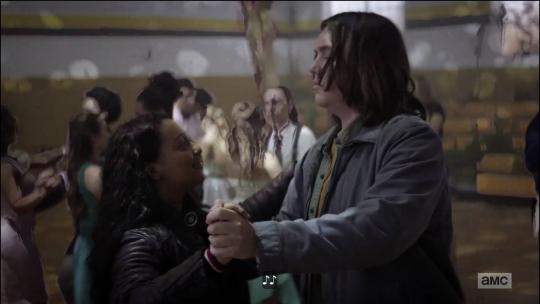
The dialogue wasn’t word for word in this case, but had a lot of the same meaning. For example, Silas says Iris is different now, being a leader. She says, “I’m trying.” And he replies, “you are.” So, we have parallels to both the line where Beth said she wished she could just change, and Daryl said she did. And also to when Beth said Daryl got away from his past. When he denies it, she says, “you did.”
Silas also opened up to Iris about the negativity in his head and how he can’t escape it on the inside. But “out here” he doesn’t hear the negative voices. It reminded me of Aaron and Daryl talking about how Daryl sometimes needed to be “out here” in 5b, with Buttons.
There was also a “you okay?” exchange, kind of like Bethyl in Beth’s cell in 4x01.
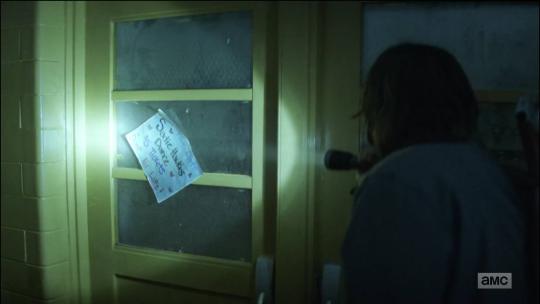
There were signs all over the school for a Sadie Hawkins dance. They made a funny joke in which neither of the kids had heard of it and assumed it was the name of a girl who went to the school. My high school did the Sadie Hawkins dance, but all I really know about it is that it was girl’s choice and less formal than prom. But I wondered if there was more to the symbolism here, because the signs for it were EVERYWHERE and it was really emphasized. So I looked it up. Look what I found:
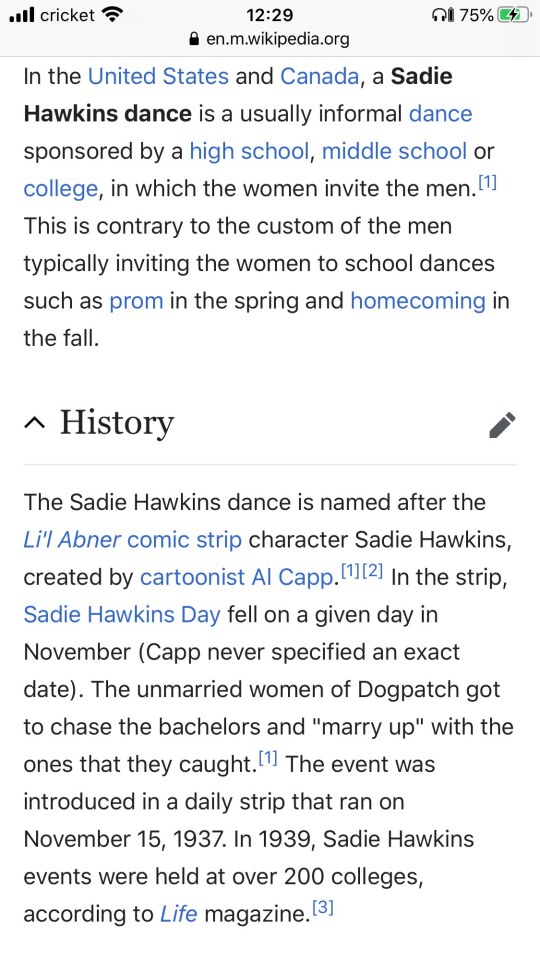
I think the emphasis of the girl’s choice is important, especially as we’re dealing with romance here and in both cases—Beth and Iris—the girl really reached out to the guy, rather than vise versa, and helped him come out of his shell and open up to her.
Also, notice the dog reference (Dogpatch) in where the Sadie Hawkins dance originated from. I’m kinda thinking that’s why the writers chose it rather than just doing a prom theme. It has canine roots! ;D Also reminds me of the “dog trot” in Still.
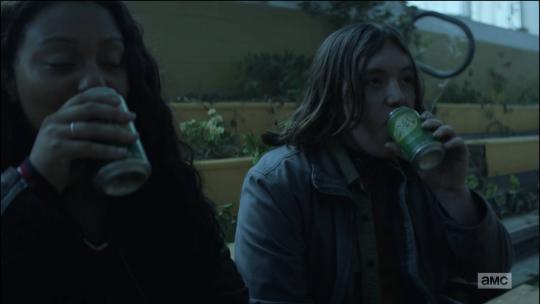
They also shared “green soda.” Obviously the green thing, but Silas just randomly found it and Iris really liked it. I feel like this was the teenaged version of Beth and Daryl’s moonshine.
There was a really adorable moment when Iris and Silas danced together to music. Obviously the music gave me Bethyl vibes. There wasn’t really any dance themes around Beth and Daryl in particular, but I couldn’t help but think of his line about singing out in public. Most of his other “I Nevers” have since come true in some way, and I’ve long suspected that, at some point, he and Beth will sing together in some capacity.
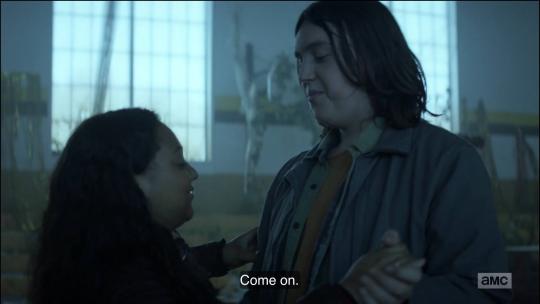
I have no idea what that will look like, but Iris and Silas dancing felt like some version of that. He kept objecting that he didn’t know how to dance, but she talked him into it and they figured it out together and were laughing and smiling and having fun. Yeah, I ship it. ;D
The next thing I noticed has to do with the Pink Theory. This episode did this thing where they kept showing flashbacks. Not of the man characters per se but of the school before the apocalypse hit. So, it would show kids walking through the halls, dancing at school dances, having fun, etc. And it kind of zeroed in on one girl who was very happy and somewhat popular. Lots of people talking to her, taking her picture, etc. She was very happy. And she had pink hair. The significance of that didn’t hit me until about halfway through.
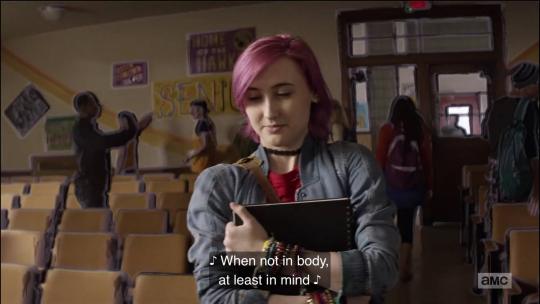
We even saw a guy at her high school smile at her, as though there might be some romance blooming there.
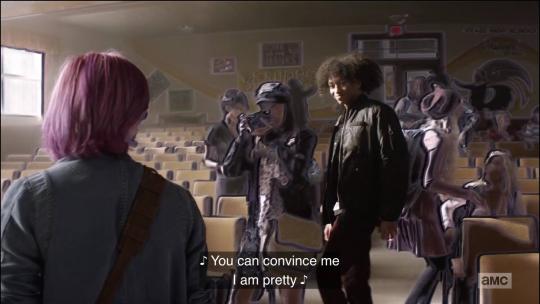
Iris sees a picture of this same girl in a yearbook. The caption says, “most likely to march to the beat of her own drum.” That made me think of Beth because 1) pink hair 2) drum = music reference and 3) Beth definitely marched to the beat of her own drum, taking a different path than the rest of the group and kind of existing outside the main story line.
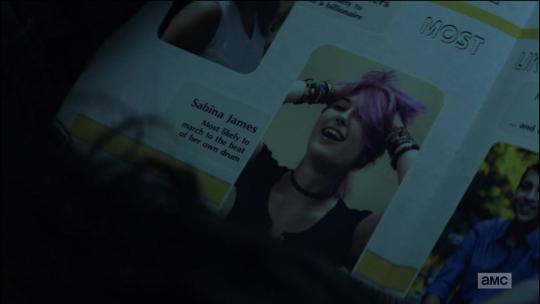
At the very end, we see a walker with pink hair. It’s obviously supposed to be her. So, it’s sad, because she died in the school. Symbol-wise, I do think she represents Beth. She was a teenager (18), enjoying her life and romance was perhaps even blooming for her, when everything was cut short. She was sort of like the sacrificial lamb.
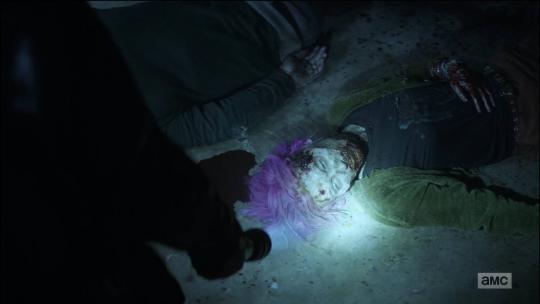
And then we have that wolf image. I feel like they’re hinting at the death of the lamb and birth of the wolf, here. And this works for these characters too as they grow and mature and leave their innocence behind. So, pretty potent—not to mention biblical—symbolism here. The lamb and the wolf are mentioned together often, especially in the book of Isaiah.
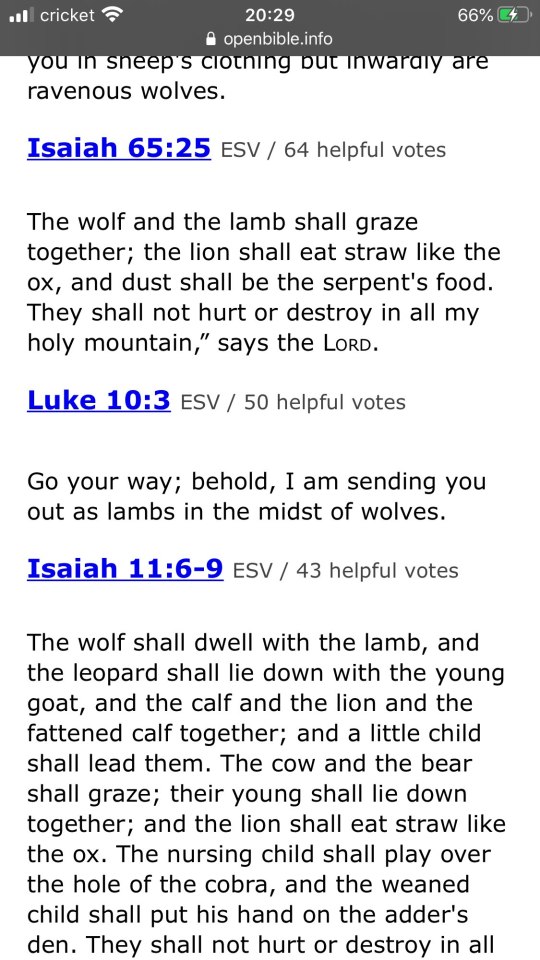
Hope and Huck find foodie supplies and there’s all kinds of symbolic goodness here. Pretty sure there’s some peanut butter on the shelf, Huck grabs sardines, which are a type of fish.
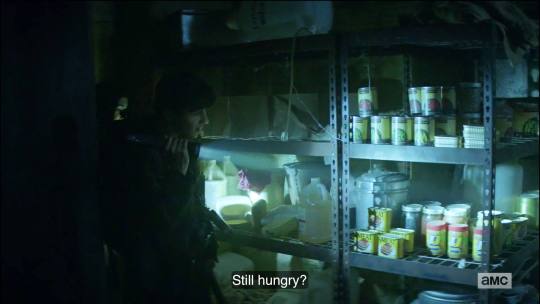
There’s a walker with a missing leg that got caught in a grate (missing foot symbolism). At one point, Silas finds a flare, which is sitting right next to a water jug. (Lots of those in the school, too.)

So, interestingly, we had the pink theme in both FTWD and TWB this week. (FTWD = Rich Bitch walker and TWB = pink haired Beth proxy.) We also saw flares lit in both. One by Al on the roof of the office building and one by Silas in the school.
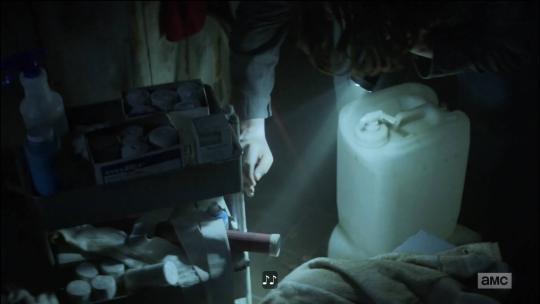

Silas has an anger moment, lashes out, and accidentally hurts Elton. He gets depressed about it and wants to be left behind, but once again, Iris reaches out to him and helps him work through it. And they all leave together at the end.
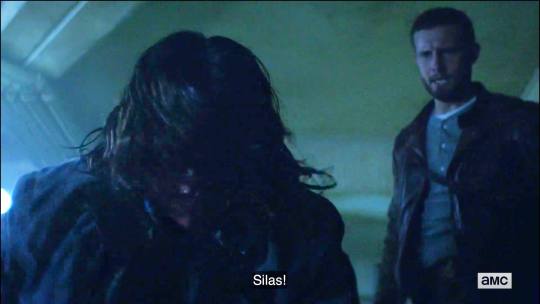
Then there’s the coda. Yes, this episode had a coda. There weren’t any SUPER obvious Beth ties, but we saw “test subjects” being experimented upon.
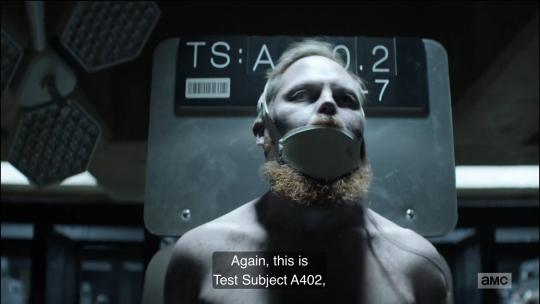
So this obviously has something to do with the girls’ dad and where they’re going. But any after-the-credits-coda I can’t help but link to Beth. And then there’s the bite/cure theory. So I’m definitely side-eyeing this. The woman we see doing the tests calls them “Test Subjects” just as Jenner did in Season 1 of TWD. Very interesting.
#beth greene#beth greene lives#beth is alive#beth is coming#td theory#td theories#team delusional#team defiance#beth is almost here#bethyl
8 notes
·
View notes
Text
Marvel’s WandaVision Episode 5: MCU Easter Eggs and Reference Guide
https://ift.tt/eA8V8J
This article contains WandaVision spoilers through episode 5, possibly beyond, and for the wider MCU.
WandaVision episode 5, “On a Very Special Episode…” took everything we liked about the first two episodes and shook them up. For the first time, we have a fully blended approach to the storytelling, with the episode alternating between the altered “sitcom” reality of Westview, NJ and the actual, current MCU events. And then there’s that multiverse-shattering ending to contend with.
There’s a lot to break down with this week’s WandaVision, so we’d better get to it…
Sitcom Influences
WandaVision took us to the ‘80s this week, with a little Growing Pains, some Family Ties, and maybe a hint of Full House thrown in for good measure. The living room set itself looks very much like the standard seen on shows of the era, specifically Family Ties and Growing Pains.
Family Ties
The aging up of Billy and Tommy is much like Andy Keaton from Family Ties. In season 4, Andy was born and spent the whole season as a baby. As of the beginning of season 5, Andy was suddenly about 5 years old with zero explanation.
Also from Family Ties is the beginning of the opening credits, where it would show someone painting a colorless sketch of the family.
Bettany’s Michael Gross impression was extremely disturbing in how good it was a couple of times.
Growing Pains
Wanda and Vision getting vaguely horny for each other while doing regular domestic stuff is reminiscent of the way the parents would occasionally get it on on Growing Pains and Family Ties.
The sitcom theme lyrics and feel are extremely Growing Pains. And yes, as you might expect, they are very appropriate for these characters.
Here are the full lyrics for you (courtesy of the Disney+ closed caption feature):
“You wander the world with a vision…Of what life could be But then the years come and teach you…To just wait and see Forces may try to pull us apart…But nothing can phase me If you’re in my heart Crossing our fingers Singing a song We’re making it up as we go along Through the highs and lows We’ll be right, we’ll be wrong We’re making it up as we go along And there will be days…We won’t know which way to go But we’ll take it higher…You’re all I desire When the going gets tough…When push comes to shove We’re making it up Cuz we got love we got love we got love We got WandaVision”
Darcy also refers to Vision “playing Father Knows Best,” a callback to the sitcom style of the first episode.
We wrote in more detail about the sitcom influences of WandaVision episode 5 here.
Scarlet Witch
For the first time, we get the names of Wanda’s parents: Irina and Oleg Maximoff, but in the comics they were known as Django and Marya.
Wanda was born in 1989, the same year as Elizabeth Olsen.
We learn here that the “Scarlet Witch” codename has never been used in the MCU
Darcy refers to the anomaly as “the hex” after the hexagonal patterns that were noted in the previous episode. In the comics, Wanda’s powers are often referred to as “hex bolts.” She could also produce “hex spheres” and the town seems to be enveloped in a large one here.
Wanda’s accent, missing since Avengers: Age of Ultron, makes its triumphant return here.
Wanda talking to the kids about how “my brother is far away from here” is technically true: his corpse is…nowhere nearby. Although given how the episode ends, she could very well have been referring to another corner of the multiverse. We’ll get to that soon enough.
SWORD seems to refer to what’s going on as “The Maximoff Anomaly.”
Vision
We now know that Vision’s corpse is physically present in Westview and he isn’t just a manifestation of Wanda’s powers, nor was the horrific image of him glimpsed at the end of episode 3 a hallucination: it was Wanda seeing him as he really is.
Vision is working on a Commodore 64 at Computational Services. This early personal computer was a terrific gaming machine, with graphics and sound that were far better than early home gaming consoles of the era.
Vision apparently had a “living will” about what he didn’t want done with his body in the event of his untimely demise. Think of it like the MCU equivalent of a DNR. No, not a “do not reveal.” The other thing.
House of M
Before Agnes shows up the second time around, Vision is reading a newspaper with the headline, “LOCAL HOMEMAKERS INNOVATING RECIPES.” Moments later, he folds the newspaper in a way so that it only says “HOM.” HOM is short for the big Scarlet Witch comic event House of M.
The Twins
While it’s used as a setup for the twins inexplicably growing up, Wanda and Vision are horrified to find that the babies have simply vanished. In the comics, the first time we really get an idea that something is wrong with the children (as well as Wanda’s mental wellbeing) is when they show us that Billy and Tommy would cease to exist when Wanda wasn’t around.
This episode is the first to really feel like it’s borrowing a lot from Wanda’s most important story: the Dark Scarlet Witch story from Avengers West Coast. In that book, the first clue that something was wrong with Wanda was how the twins would disappear when she wasn’t looking a them. This would often happen when Agatha Harkness (presumably Agnes here) was babysitting for them. And later, Wanda’s personality started to shift towards full villainy and she was very cavalier about the use of her powers, something we start to see in this episode.
For most of the episode, the twins are dressed in red and green. This more than a nod to their parents’ favored color schemes, but it appears to mirror the colors they adopt when they grow up to be superheroes themselves. William becomes the hex-wielding Wiccan, who favors red, while Tommy favors green (like his Uncle Pietro) as Speed.
Sparky
Poor Sparky. Good boy.
The name “Sparky” is a reference to Tom King and Gabriel Hernandez Walta’s brilliant Vision story, in which Vision and his “family” (not the Maximoffs) move to the suburbs and try to live a “normal” life. Part of that includes a synthezoid canine named “Sparky.” He didn’t meet a good end there, either. Stop letting dogs die in our stories, you monsters! It’s too sad.
Lagos
This week’s commercial is for Lagos Brand Paper Towels, with the catchy slogan of: “For when you make a mess you didn’t mean to.”
This references the opening scenes of Captain America: Civil War, when Wanda used her powers to stop Crossbones from detonating a bomb in a crowded marketplace. While she reduced the number of casualties overall, a number of innocent civilians still died when he exploded. It’s the first indication that Wanda’s grief and trauma in Westview are driven by far more than just the loss of her lover.
The Lagos ad is also another reference to the Infinity Stones. Previously, we’ve had the toaster (Power), the watch (Time) and the Tesseract-shaped bath powder (Space). Here, we have a red liquid spill in a sly nod to the Aether (Reality). Only the Mind and Soul stones to go – which means two more commercials.
X-Men
These are definitely not the only X-Men references in the episode (of course), but we’ll get to that big one down below…
The scene of Wanda confronting SWORD agents looks to be directly inspired by the scene in the first X-Men movie where the police try to take down Magneto. Much like Wanda, he uses his powers on their guns, causing them to be aimed at the cops themselves before escaping. Considering the payoff to this episode and Magneto’s role as Wanda and Pietro’s sometimes-father in the comics (not to mention Pietro’s definite father in the X-Men movies), this was more than likely set up.
Vision says he was reading Charles Darwin’s “The Descent of Man” to one of the twins, a book that deals with evolution. (David Bowie voice) “Gotta make way for the homo superior!”
The Twilight Zone
Serious Twilight Zone “It’s a Good Life” vibes in the episode throughout, particularly when Agnes is visibly weirded out by Wanda with her “take it from the top” moment (unless she’s deliberately screwing with everyone), and the mailman telling the twins “your mom won’t let [Sparky] get far.”
Also, while we’re on the subject of The Twilight Zone, Agnes appears to live at the corner of Maple St. and Sherwood Drive. “The Monsters are due on Maple Street” is a notoriously paranoid unpacking of suburban paranoia.
Westview
The opening credits feature a “Greetings From Westview, NJ” postcard in a pretty common format, but one made most famous on the cover of Bruce Springsteen’s “Greetings From Asbury Park” album.
We wrote more about Westview in general here.
“For the Children
Vision points out that there are “no other children in Westview,” which calls to mind the creepy “for the children” chant from back in episode 2.
Captain Marvel
Darcy draws the connection between how both Wanda and Carol Danvers got their powers via an Infinity Stone. Similarly, they acknowledge Wanda almost took out Thanos in Avengers: Endgame but that this feels outside the scope of her powers. Still, the fact that both Wanda and Carol stood up to Thanos isn’t something that’s being glossed over in the MCU.
Note Monica’s reaction when the name “Captain Marvel” is said isn’t exactly what you’d call enthusiastic.
Monica Rambeau
Monica’s test results coming back blank seem pretty significant. Is this a signifier that her molecular structure has changed, whether from the blip or passing through the hex barrier? Are we witnessing Monica’s superheroic origin story in slow motion?
Who is the Villain of WandaVision, anyway?
Despite the implications from the end of episode 4, Wanda isn’t completely in control of what’s going on. At various points in the episode she seems to be manipulating everything, but at others seems to be completely immersed in this reality.
But if she doesn’t remember how this all started, that sets up a potential villain reveal (or more than one) down the road.
What’s up with Agnes?
Agnes is complicit but was disturbed by Wanda’s ability to “resurrect” so how much can she really know? Unless, of course, she’s just “acting” this way to continue with her cover.
On the other hand, Agnes “helping out with the kids” is kind of in line with our Agatha Harkness theory for the character.
Reed Richards?
Monica mentions that she has a particular “aerospace engineer” in mind to call for help. Based on all the other subtle Fantastic Four clues that were in the fourth episode, could this individual be Reed Richards?
If they aren’t taking that big a swing, it could be Adam Bernard Brashear, known as “The Blue Marvel,” another prominent Marvel scientist, and one who has led the 616 version of the Ultimates with Monica on the team.
Evan Peters is Pietro
“She recast Pietro?”
Yes, you are indeed seeing Evan Peters returning as Pietro Maximoff/Quicksilver here. This is (at least until it’s revealed that the MCU Wanda and Pietro were indeed mutants whose powers were merely “activated” by Strucker’s experiments) now officially the first appearance of a mutant/member of the X-Men in the MCU. Peters, of course, played Pietro in three films,X-Men: Days of Future Past, X-Men: Apocalypse, and Dark Phoenix. While Aaron Taylor-Johnson played Pietro in Avengers: Age of Ultron, Peters played him in Days of Future Past, and he was generally more warmly-received by fans.
And does this indeed mean that Pietro is alive again, albeit in “recast” form? Or is Wanda so powerful that she ripped open a hole in the multiverse itself in order for her brother to “make a guest appearance” in Westview? This could very well be the first indication of what’s to come in Doctor Strange in the Multiverse of Madness and the possibly Spiderverse-y Spider-Man 3.
Unless…what if this isn’t Pietro at all? What if it’s someone manipulative merely taking the form of Pietro to mess with Wanda even further?
Also, Pietro’s “bad boy” appearance very much feels like it fits with the Family Ties aesthetic. His “New York tough guy” look and persona is much like Nick, Mallory’s idiot boyfriend. Coincidentally, Nick also starred in an episode of the show where he got a dog and it died soon after from an accident.
We wrote much more about the shocking WandaVision episode 5 ending here.
We Are Kind of OK With the ’80s
Jazzercise was indeed a real thing, god help us.
For those of you thinking the internet was a whatever a reverse anachronism is, we made the same mistake too. But it turns out it has been around in some form since the 1960s, when the Advance Research Projects Agency (precursor to today’s US government mad science agency, DARPA) networked a few computers and sent messages back and forth.
Unanswered Questions
Dennis the Mailman is back from episode 1. His little aside to the kids is an indicator that he is vaguely aware of what’s really going on. Not necessarily in a sinister way, but a reminder that the people of Westview aren’t really enjoying this.
One of the camera feeds we see is from Satellite 348. Avengers #348 had a Vision-centric cover and story.
Is there a significance to the stuffed animal on the chair at the beginning? I thought maybe it was a stuffed Bova or something, but I think it’s just a bunny.
cnx.cmd.push(function() { cnx({ playerId: "106e33c0-3911-473c-b599-b1426db57530", }).render("0270c398a82f44f49c23c16122516796"); });
Spot anything we missed? Let us know in the comments!
The post Marvel’s WandaVision Episode 5: MCU Easter Eggs and Reference Guide appeared first on Den of Geek.
from Den of Geek https://ift.tt/3pZW8jy
0 notes
Text
This year once again, Breguet joins Only Watch, the major international charity project sponsored by the Monegasque Association against Muscular dystrophy with the Breguet Type 20 Only Watch 2019. This biannual event has been held since 2005 and has benefited from the support of Breguet and the high patronage of HRH Prince Albert II since the very beginning. An exceptional auction sale conducted by Christie’s will be taking place in Geneva for the benefit of medical research on muscular dystrophy on Saturday, November 9, 2019. Sensitive to the gravity of these diseases and keen to demonstrate his commitment to aid ailing children, Marc A. Hayek, President of Montres Breguet, will once again make a contribution by offering a one-of-a-kind watch.
Breguet Type 20 Only Watch 2019
Breguet, a Great Name in Watchmaking and Aviation
The House of Breguet showed an early interest in watches designed for aviation, highlighting how watchmaking should contribute to progress in air navigation just as it had done previously for marine navigation. From 1918 onwards, the House of Breguet provided several timepieces for the American Air Force and in 1922 for the Société d’Aviation Louis Breguet, a company founded by a descendant of Abraham-Louis Breguet. These instruments gradually became chronographs with counters and tachometers, which could either be worn by the pilots or affixed to the plane’s dashboard. Breguet continued to provide increasingly sophisticated chronographs to various aviation and aircraft companies. However, the most important chapter in the history of the Breguet pilot watch began with the Type XX.
In the early fifties, the French Ministry of Defense drew up specifications with a view to purchasing chronograph wristwatches for its Air Force, to be known as Type 20. Drawing on its experience in this area, Breguet expressed its interest and designed a model that was quickly approved by the authorities. The year was 1954 and the legend of the Type XX had just begun.
The Type 20 was introduced as a pilot watch equipped with a flyback chronograph, the emblematic function of this watch. The flyback function allows for the chronograph function to be reset to zero by simply pressing the lower pushbutton, simplifying the pilot or team members’ operations and offering the possibility of recording several consecutive times.
It is worth noting that in the house’s books, the military models are referred to as Type 20 and the civilian models as Type XX. The Type XX chronograph evolved through three successive generations, each with several varieties that today arouse a growing desire among collectors.
Breguet Type 20 Only Watch 2019
The Type 20 Only Watch 2019
In homage to both watchmaking and aviation, Breguet is reissuing a unique version of its Type 20 pilot chronograph from the fifties in a form that is very faithful to the original, both esthetically and mechanically.
Its steel case preserves the historical diameter of 38.30 mm, the unique curved horns with lateral bevel, and the pear-shaped crown, typical of the first-generation military models delivered to the French Air Force and Naval Air Force. From this desire for accuracy, the new model is equipped with a bidirectional bezel in fluted steel without graduations, along with triangular markings for flight calculations.
The dial of the watch is inspired by the very rare civilian and military models with a bronze-colored dial sold at the time. Some black dials also took on a shade of bronze after long exposure to the sun. The Type 20 Only Watch 2019 displays small seconds and a 30-minute totalizer. It offers sharp legibility in all conditions and sports the distinctive hands of the historical Type XX watches, which are treated with Super-LumiNova®, as well as the large Arabic numerals. A notable difference between the Type 20 Only Watch 2019 and the Air Force’s historical model is the Breguet signature at 12 o’clock.
The Type 20 Only Watch 2019 is faithful not only visually to the watch that it is inspired from, but also in its movement: the Valjoux 235 13 lignes, which is derived directly from the Valjoux 222 14 lignes used in the fifties. The movement blank of this manually wound, column-wheel chronograph was restored back to working order, so as to ensure the Type 20 Only Watch 2019 is endowed with the same proportions and functions. This movement is, of course, fitted with the flyback function, without which it could never be a true Type 20 pilot chronograph.
The Breguet Type 20 Only Watch 2019 is equipped, like the original, with a steel screw-down caseback, which offers water resistance up to 30 meters. On the caseback, the owner of this exclusive watch will find an inscription that reads: “Breguet Type 20 Only Watch 2019 Pièce Unique”. This model will be offered in a presentation box shaped like an airplane’s wing.
#gallery-0-7 { margin: auto; } #gallery-0-7 .gallery-item { float: left; margin-top: 10px; text-align: center; width: 50%; } #gallery-0-7 img { border: 2px solid #cfcfcf; } #gallery-0-7 .gallery-caption { margin-left: 0; } /* see gallery_shortcode() in wp-includes/media.php */
About Breguet
The House of Breguet, founded in 1775 by Abraham-Louis Breguet (1747–1823), holds a unique position in the world of watchmaking. Acknowledged as one of the most prolific inventors of his time, having developed the tourbillon, gong spring, pare-chute shock protector, and Breguet balance spring, Abraham-Louis Breguet received recognition for his creativity and talent across a number of Europe’s royal courts. In 1815, King Louis XVIII of France would go on to appoint him Chronometer-maker to the Royal Navy. This marked the beginning of a long tradition of putting the house’s expertise to work for navigators, first for those in the navy and then for aviation.
www.breguet.com @montresbreguet #BreguetOnlywatch #onlywatch #onlywatch2019
Breguet Type 20 Only Watch 2019 Technical Specification
RÉF. 2055ST/Z5/398
Case: round steel case. Solid caseback with engraving “Breguet Type 20 Only Watch 2019 Pièce Unique”. Diameter 38.30 mm. Thickness 13.90 mm. Bidirectional rotating bezel with triangular markings for flight calculations. Rounded lugs. Pear-shaped crown. Water-resistant to 3 bar (30 meters).
Dial: bronze colored, signed Breguet. Hours chapter with luminescent Arabic numerals. 30-minute counter at 3 o’clock. Small seconds at 9 o’clock. Central chronograph counter. Luminescent hands.
Movement: mechanical manually wound movement, column-wheel chronograph with flyback function. Numbered and signed Breguet. Cal. Valjoux 235. 13 lignes. 17 jewels. 45-hour power reserve. 183 components. In-line Swiss lever escapement. Annular balance wheel. Flat balance spring. Frequency 3 hertz.
Strap: calfskin leather.
Unique piece for Only Watch 2019.
Breguet Type 20 Only Watch 2019
Breguet Type 20 Only Watch 2019
Breguet Type 20 Only Watch 2019 This year once again, Breguet joins Only Watch, the major international charity project sponsored by the Monegasque Association against Muscular dystrophy with the Breguet Type 20 Only Watch 2019.
0 notes
Text
Prototype 1969 Ford Boss Bronco Resurfaces After 40 Years
Wes Eisenschenk could hardly believe his eyes when he plugged the serial number into Google in 2016 and found a long missing 1969 Ford prototype.
“There it was, the missing 1969 Ford Boss Bronco prototype, in an expired eBay listing.”
A Boss Bronco? Yes, Ford did build, at its legendary clandestine enterprise Kar-Kraft, a prototype high performance Boss Bronco in 1969. It featured a blueprinted 1969 GT 350 Shelby engine, a Hi-Po C4 automatic, and 4.11 limited slip gears front and rear among other truly muscular details. And it somehow survived under the radar for more than 40 years in fantastic original condition.
Wes is an editor at CarTech, the publisher that recently produced the new book, Kar-Kraft: Race Cars, Prototypes and Muscle Cars of Ford’s Special Vehicles Activity Program, by Charlie Henry. Research for this book dredged up the VIN for the Boss Bronco prototype, which was built to prove the concept of a production high-performance Bronco for then Ford President Bunkie Knudsen, who with his cohort from GM, Larry Shinoda, is largely responsible for Ford’s original Boss Mustang program of 1969-1971.
The team at Kar-Kraft started with a specially equipped 1969 Bronco Sport sent to them directly from the Ford assembly line. It was equipped with a 302 V-8, 4.11 gears with limited slip, and—likely as no coincidence—it was finished in the rare Empire paint, a shade of yellow that matched what was known to be Knudsen’s favorite color. After all, nothing is sacred when looking to have a prototype approved by the Boss!
To make sure this project, originally referred to as simply the Special Bronco in internal documents, would be everything a high-performance Bronco should be, Kar-Kraft also called in Bill Stroppe to oversee the build effort for this special truck. Stroppe, who was running Ford’s off-road racing team, certainly had more than enough experience to know what it would take to build a righteous Bronco after fielding a team of them to victories for Ford.
Among the modifications chosen by the Kar-Kraft team and Stroppe for the Special Bronco, which was soon re-named the Boss Bronco, ostensibly to tie in to Ford’s existing line of Boss cars beyond just the obvious homage to Knudsen, was adding more power. This was accomplished by swapping in a 1969 GT 350 210-S-code 351 four-barrel Windsor motor, although the one provided for the Boss Bronco by Ford was also balanced and blueprinted, much as the “bone stock” engines used for magazine road test cars were back in the day. It exhaled through a true dual exhaust with glasspack mufflers. Backing up this warmed over 351W was a custom Kar-Kraft-fabricated adapter that allowed a Hi-Po C4 automatic transmission to be fitted as well, the first automatic transmission installed in a Bronco by Ford.
Stroppe dual shocks were installed at all four corners to help keep the big 15×10-inch chrome wheels and 10-15LT Gates Commando tires on the ground when the going got rough.
Inside, a Stroppe padded steering wheel, Stroppe rollbar, and a Mustang shifter for the C4 were installed, along with custom upholstered panels and aluminum trim to finish the inside of the rear quarter-panels and tailgate for a more upscale look. On the outside the rear wheel wells were cut and Stroppe fender flares installed for the needed tire clearance, a Cougar Eliminator hood scoop bolted on, and finally the black hockey-stick stripes with BOSS BRONCO lettering was applied.
The finished package was quite impressive. It clearly not only looked the part but performed as well as they hoped their special high-performance Bronco would.
Yet, as good as it was, as luck would have it Lee Iacocca famously fired Knudsen before a production Boss Bronco could get off the ground. Afterwards, inventory sheets show Kar-Kraft was supposed to crush the one and only prototype.
But somehow it escaped. Exactly how is still unknown, but experts suspect it was simply sold to an employee when Kar-Kraft was liquidated in late 1970. But no matter how it made it into the wild, Wes was the extremely lucky soul who found the Boss Bronco many decades later. The muscle truck had sold outside of eBay, so Wes searched and found the ultimate buyer, a man in Washington State, who agreed to sell the Bronco for a nice profit. Wes then posted a picture of the rare prototype on an Internet forum looking for further info on it. And that’s when Colin Comer saw it.
Colin owns Colin’s Classic Automobiles located in Milwaukee, Wisconsin. He is also a diehard Ford and Shelby authority and collector and has authored numerous books on the subject. He and Wes had worked together at another publishing company, which is how they became friends.
“As soon as I saw Wes’s post on the Boss Bronco, I immediately emailed him and said I had to have it,” Colin said. “Being a huge Ford muscle guy, as well as a long-time early Bronco owner, how could I not? I had no idea the Boss Bronco had survived. To me it is one of the ultimate early Broncos. Plus the Kar-Kraft and Stroppe connection is just so cool. I didn’t get much sleep until I convinced my buddy Wes to sell it to me! Once we arrived at a deal, I had to sell my Holman-Moody-built 1969 Bronco to help fund the Boss, but I have no regrets.”
Colin was clearly ecstatic to find himself the owner of a significant Ford prototype built at Kar-Kraft.
“The truck was painted once but otherwise untouched. There is zero rust anywhere, which is very rare for an early Bronco. It still has all of its original finishes underneath. It has the original Kar-Kraft-installed Mustang shifter for the C4 automatic and the fabricated transmission adaptor they made, and still had the original engine with its original 210-S tag. Everything down to the original carburetor and original prototype dual exhaust is still on the truck. It shows 60,000 miles and 47 years of use, but it is amazingly all there. And that’s what matters.”
Colin compared original Ford photos of the truck from Kar-Kraft to find the original hockey-stick stripe dimensions had been changed slightly during the repaint, and the Boss Bronco decals were long gone. Most probably Kar-Kraft pulled those off before selling the truck to disguise its prototype status.
Colin calculated the original stripe dimensions using the 1969 factory photos and by finding remnants of the originals in the door jambs, then re-sprayed the stripes correctly. He then had a new set of Boss Bronco decals made to return the truck to its original prototype appearance. The Boss Bronco, now out of hiding, sees frequent use by Colin, who has already added a few thousand miles to its odometer. He believes it’s a shame the Boss Bronco never made it to production, as it “would have been a big hit” in 1969, “much like the Ford Raptor is today.”
At a Glance 1969 Boss Bronco Owned by: Colin Comer Restored by: Unrestored Engine: 351ci/290hp 210-S Windsor V-8 Transmission: C4 3-speed automatic Axles: Dana 30 front, Ford 9-inch rear with 4.11 gears and limited slip Interior: White vinyl bucket seat Wheels: 15×10 custom Tires: 32×11.50R15LT BFGoodrich All-Terrain T/A KO2 Special parts: Shelby GT 350 210-S engine; C4 transmission with Mustang shifter; special paint, stripes, and decals; Stroppe rollbar, dual shocks and fender flares; Cougar Eliminator hood scoop; custom wheels Captions
The Boss Bronco parked outside Ford Styling in 1969. The Bronco had been repainted years ago, and current owner Colin Comer used this photo when re-applying the hockey-stick stripe and Boss Bronco decals to calculate their correct dimensions.
The Boss Bronco was found in excellent original condition. One man owned the Bronco for nearly 40 years. His family called it the “Bumblebee Bronco.”
When Colin got the Boss Bronco, it wore a new set of “huge 15-inch American Racing wheels” put on by the Washington State owner. Colin had a set of custom 15-inch chrome wheels made, with 10-inch hoops welded to Ford centers, to duplicate the original wheels—the same kind of wheels also used on other Stroppe trucks and Baja Broncos that followed.
In production trim, the Bronco’s largest engine in 1969 was a 302. Kar-Kraft installed a warmed-over 351 Windsor. It wasn’t a full Boss V-8, but a performance motor from the 1969 Shelby GT 350.
Incredibly, the original engine tag was still on the 351 Windsor. The 210-S designation decodes as an M-code 351 Windsor four-barrel engine for a GT 350 with a four-speed manual transmission. The other data on the tag: A6-January 6; 351-engine size; E69-E for Windsor plant, 69 for 1969; 3-change level, denoting a mid-year change to the engine.
Kar Kraft used an off-the-shelf Cougar Eliminator hood scoop on the Boss Bronco prototype. This Ford may be a 4×4 Bronco, but it’s a muscle Bronco. Imagine a Shelby GT 350 engine spinning 4.11 gears front and rear!
The interior was in good condition, as found, but Colin tracked down N.O.S. seat material to re-cover the splitting front seat cushions.
Kar-Kraft converted the manual transmission to a C4, making this the first Bronco known to receive an automatic at Ford. (The lever in front of the C4 shifter is for the Bronco’s transfer case.) Bill Stroppe was running Ford’s off-road racing team in 1969 and flew into Detroit for nine days to help engineer the Boss Bronco build.
A Stroppe rollbar was part of the Boss Bronco prototype build. Kar-Kraft used Premier brand aircraft-spec bolts, just as it did on the GT-40 program.
Colin brought the Boss Bronco to the Muscle Car and Corvette Nationals in 2017 to be part of the special Kars of Kar-Kraft display.
Research for this new book by Charlie Henry, published by “CarTech” is the catalyst that found the Boss Bronco. (CarTech Books Photo)
(Jerry Heasley photo)
The post Prototype 1969 Ford Boss Bronco Resurfaces After 40 Years appeared first on Hot Rod Network.
from Hot Rod Network http://www.hotrod.com/articles/prototype-1969-ford-boss-bronco-resurfaces-40-years/ via IFTTT
0 notes
Text
(Hu)go Template Primer
Hugo uses the excellent go [html/template][gohtmltemplate] library for its template engine. It is an extremely lightweight engine that provides a very small amount of logic. In our experience that it is just the right amount of logic to be able to create a good static website. If you have used other template systems from different languages or frameworks you will find a lot of similarities in go templates.
This document is a brief primer on using go templates. The [go docs][gohtmltemplate] provide more details.
Introduction to Go Templates
Go templates provide an extremely simple template language. It adheres to the belief that only the most basic of logic belongs in the template or view layer. One consequence of this simplicity is that go templates parse very quickly.
A unique characteristic of go templates is they are content aware. Variables and content will be sanitized depending on the context of where they are used. More details can be found in the [go docs][gohtmltemplate].
Basic Syntax
Go lang templates are html files with the addition of variables and functions.
Go variables and functions are accessible within {{ }}
Accessing a predefined variable "foo":
{{ foo }}
Parameters are separated using spaces
Calling the add function with input of 1, 2:
{{ add 1 2 }}
Methods and fields are accessed via dot notation
Accessing the Page Parameter "bar"
{{ .Params.bar }}
Parentheses can be used to group items together
{{ if or (isset .Params "alt") (isset .Params "caption") }} Caption {{ end }}
Variables
Each go template has a struct (object) made available to it. In hugo each template is passed either a page or a node struct depending on which type of page you are rendering. More details are available on the variables page.
A variable is accessed by referencing the variable name.
{{ .Title }}
Variables can also be defined and referenced.
{{ $address := "123 Main St."}} {{ $address }}
Functions
Go template ship with a few functions which provide basic functionality. The go template system also provides a mechanism for applications to extend the available functions with their own. Hugo template functions provide some additional functionality we believe are useful for building websites. Functions are called by using their name followed by the required parameters separated by spaces. Template functions cannot be added without recompiling hugo.
Example:
{{ add 1 2 }}
Includes
When including another template you will pass to it the data it will be able to access. To pass along the current context please remember to include a trailing dot. The templates location will always be starting at the /layout/ directory within Hugo.
Example:
{{ template "chrome/header.html" . }}
Logic
Go templates provide the most basic iteration and conditional logic.
Iteration
Just like in go, the go templates make heavy use of range to iterate over a map, array or slice. The following are different examples of how to use range.
Example 1: Using Context
{{ range array }} {{ . }} {{ end }}
Example 2: Declaring value variable name
{{range $element := array}} {{ $element }} {{ end }}
Example 2: Declaring key and value variable name
{{range $index, $element := array}} {{ $index }} {{ $element }} {{ end }}
Conditionals
If, else, with, or, & and provide the framework for handling conditional logic in Go Templates. Like range, each statement is closed with end.
Go Templates treat the following values as false:
false
0
any array, slice, map, or string of length zero
Example 1: If
{{ if isset .Params "title" }}<h4>{{ index .Params "title" }}</h4>{{ end }}
Example 2: If -> Else
{{ if isset .Params "alt" }} {{ index .Params "alt" }}
{{else}} {{ index .Params "caption" }} {{ end }}
Example 3: And & Or
{{ if and (or (isset .Params "title") (isset .Params "caption")) (isset .Params "attr")}}
Example 4: With
An alternative way of writing "if" and then referencing the same value is to use "with" instead. With rebinds the context . within its scope, and skips the block if the variable is absent.
The first example above could be simplified as:
{{ with .Params.title }}<h4>{{ . }}</h4>{{ end }}
Example 5: If -> Else If
{{ if isset .Params "alt" }} {{ index .Params "alt" }} {{ else if isset .Params "caption" }} {{ index .Params "caption" }} {{ end }}
Pipes
One of the most powerful components of go templates is the ability to stack actions one after another. This is done by using pipes. Borrowed from unix pipes, the concept is simple, each pipeline's output becomes the input of the following pipe.
Because of the very simple syntax of go templates, the pipe is essential to being able to chain together function calls. One limitation of the pipes is that they only can work with a single value and that value becomes the last parameter of the next pipeline.
A few simple examples should help convey how to use the pipe.
Example 1 :
{{ if eq 1 1 }} Same {{ end }}
is the same as
{{ eq 1 1 | if }} Same {{ end }}
It does look odd to place the if at the end, but it does provide a good illustration of how to use the pipes.
Example 2 :
{{ index .Params "disqus_url" | html }}
Access the page parameter called "disqus_url" and escape the HTML.
Example 3 :
{{ if or (or (isset .Params "title") (isset .Params "caption")) (isset .Params "attr")}} Stuff Here {{ end }}
Could be rewritten as
{{ isset .Params "caption" | or isset .Params "title" | or isset .Params "attr" | if }} Stuff Here {{ end }}
Context (aka. the dot)
The most easily overlooked concept to understand about go templates is that {{ . }} always refers to the current context. In the top level of your template this will be the data set made available to it. Inside of a iteration it will have the value of the current item. When inside of a loop the context has changed. . will no longer refer to the data available to the entire page. If you need to access this from within the loop you will likely want to set it to a variable instead of depending on the context.
Example:
{{ $title := .Site.Title }} {{ range .Params.tags }} <a href="%7B%7B%20%24baseurl%20%7D%7D/tags/%7B%7B%20.%20%7C%20urlize%20%7D%7D">{{ . }}</a> - {{ $title }} {{ end }}
Notice how once we have entered the loop the value of {{ . }} has changed. We have defined a variable outside of the loop so we have access to it from within the loop.
Hugo Parameters
Hugo provides the option of passing values to the template language through the site configuration (for sitewide values), or through the meta data of each specific piece of content. You can define any values of any type (supported by your front matter/config format) and use them however you want to inside of your templates.
Using Content (page) Parameters
In each piece of content you can provide variables to be used by the templates. This happens in the front matter.
An example of this is used in this documentation site. Most of the pages benefit from having the table of contents provided. Sometimes the TOC just doesn't make a lot of sense. We've defined a variable in our front matter of some pages to turn off the TOC from being displayed.
Here is the example front matter:
--- title: "Permalinks" date: "2013-11-18" aliases: - "/doc/permalinks/" groups: ["extras"] groups_weight: 30 notoc: true ---
Here is the corresponding code inside of the template:
{{ if not .Params.notoc }} <div id="toc" class="well col-md-4 col-sm-6"> {{ .TableOfContents }} </div> {{ end }}
Using Site (config) Parameters
In your top-level configuration file (eg, config.yaml) you can define site parameters, which are values which will be available to you in chrome.
For instance, you might declare:
params: CopyrightHTML: "Copyright © 2013 John Doe. All Rights Reserved." TwitterUser: "spf13" SidebarRecentLimit: 5
Within a footer layout, you might then declare a <footer> which is only provided if the CopyrightHTML parameter is provided, and if it is given, you would declare it to be HTML-safe, so that the HTML entity is not escaped again. This would let you easily update just your top-level config file each January 1st, instead of hunting through your templates.
{{if .Site.Params.CopyrightHTML}}</footer><footer><div class="text-center">{{.Site.Params.CopyrightHTML | safeHtml}}</div> </footer>{{end}}
An alternative way of writing the "if" and then referencing the same value is to use "with" instead. With rebinds the context . within its scope, and skips the block if the variable is absent:
{{with .Site.Params.TwitterUser}}<span class="twitter"> <a href="https://twitter.com/%7B%7B.%7D%7D" rel="author"> <img src="/images/twitter.png" width="48" height="48" title="Twitter: {{.}}" alt="Twitter"></a> </span>{{end}}
Finally, if you want to pull "magic constants" out of your layouts, you can do so, such as in this example:
<nav class="recent"><h1>Recent Posts</h1> <ul><li><a href="%7B%7B.RelPermalink%7D%7D">{{.Title}}</a></li> </ul></nav>
0 notes